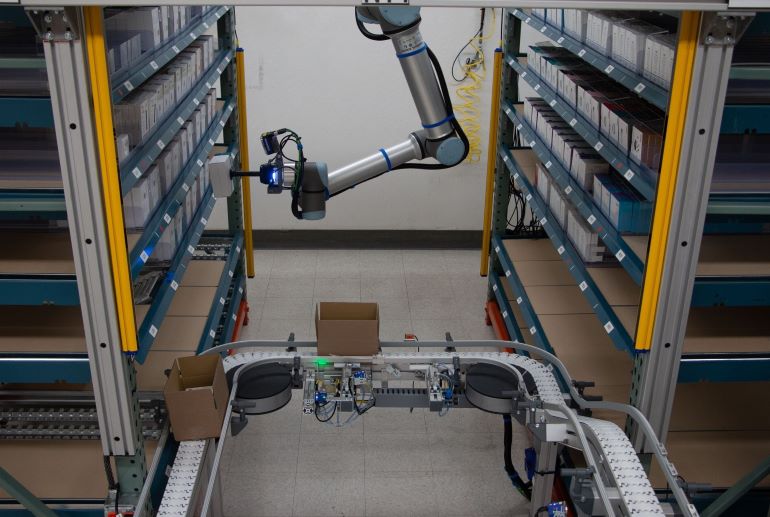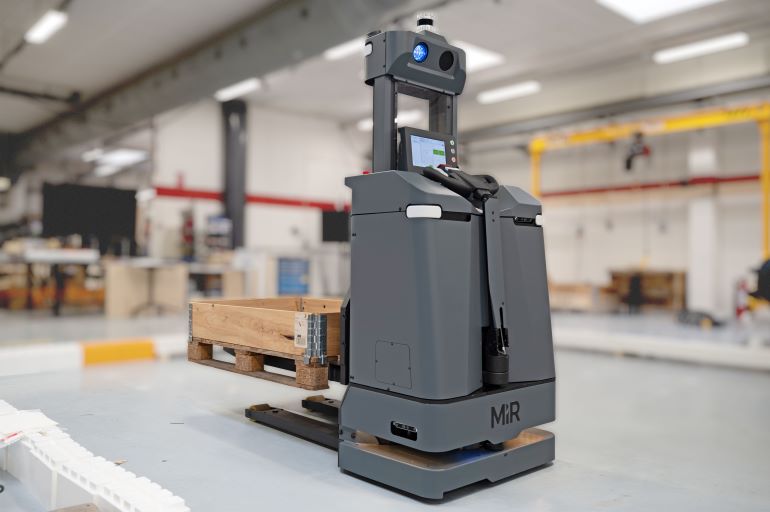|
Listen to this article |

SAN JOSE, Calif. — Artificial intelligence is already making robots smarter. Teradyne Robotics announced at GTC 2024 a collaboration with NVIDIA to add new AI capabilities to collaborative and mobile robots.
North Reading, Mass.-based Teradyne owns collaborative robot maker Universal Robots A/S (UR) and autonomous mobile robot (AMR) company Mobile Industrial Robots A/S (MiR), both of which are in Odense, Denmark.
“This is the first of a series of planned AI offerings by Teradyne Robotics,” stated Ujjwal Kumar, group president of Teradyne Robotics. “By adding high-performance compute hardware to our control systems, as well as investing in targeted upgrades to our software stacks, we are investing to establish UR and MiR as the preferred robotics platforms for developing and deploying AI applications.”
“We are working to shape the future of robotics by combining NVIDIA’s state-of-the-art AI platform with Teradyne Robotics’ real-world domain expertise in industrial automation,” he added. “We’re creating the platform for new solutions to previously unsolvable problems.”
Kumar will deliver a keynote at the Robotics Summit & Expo in Boston in May.
Universal Robots integrates accelerated computing
Universal Robots is demonstrating at this week’s GPU Technology Conference (GTC) an autonomous inspection system using its cobot arms and AI. The company has integrated NVIDIA accelerated computing into its cobots for path planning 50 to 80 times faster than today’s applications.
“NVIDIA has been working with Universal Robots for three years,” Kumar explained to Collaborative Robotics Trends. “Its researchers were used to the UR cobots, which are inherently safe and thus good for testing AI.”
“While the Microsofts and Googles of the world may own digital AI, NVIDIA wants to be the market leader in physical AI, as CEO Jensen Huang mentioned in his keynote,” he said. “In digital AI, 90% might be OK for an image or text generated with AI, but that’s not sufficient in the real world. Teradyne has experience with quality and reliability.”
The partners said the application combines the following to increase efficiency for automation customers:
The combination of cuMotion, PolyScope X, and the UR cobot makes possible a range of applications that were previously not feasible to automate fully, according to the partners. It can also improve existing programming concepts.
Teradyne and NVIDIA cited benefits including ease of programming and lower computation time for planning, optimizing, and executing trajectories. For customers, this technology can simplify the setup of common industrial applications, facilitating robot adoption for high-mix, low-volume scenarios.
Not only can cuMotion allow automatic calculation of path planning for collision-free trajectories, but it also enables path optimization for other criteria such as speed, minimum wear, or energy efficiency, according to Universal Robots.
At the GTC demonstration, The Robot Report watched the cobot-mounted camera move to inspect a workpiece that was randomly reoriented. It did so automatically, and a digital twin mirrored its maneuvers.
For the inspection application, users can load CAD files for up to 20 parts with associated test procedures. NVIDIA’s technology enables the robot to identify each part and procedure and conduct path planning accordingly, explained Andrew Pether, principal innovation research engineer at Universal Robots. He said the combination of cuMotion on AGX Orin for dynamic positioning, Isaac Sim for digital twins of the current state and trajectories can improve inspections for automotive, large electronics, and “white goods”/appliances manufacturers.

Teradyne, NVIDIA expect AI robotics apps to grow
Mobile Industrial Robots also announced the MiR1200 Pallet Jack, which uses the NVIDIA Jetson AGX Orin module for AI-powered pallet detection. This enables it to identify and precisely move objects, navigate autonomously, and operate in complex factory and warehouse environments.
“There are two kinds of workers in factories or warehouses — those in static cells or who are moving,” said Kumar. “We have robots to help both sorts of tasks. Mobile robots and cobots could jointly meet needs in welding, semiconductors, and more.”
Teradyne noted that autonomous inspection and the autonomous pallet handling are two use cases with significant potential for scalability. The MiR1200 Pallet Jack and UR’s cuMotion demo are the two most recent examples of “physical AI” solutions, with others already available through Teradyne Robotics’ ecosystem partners, OEMs, and end users.
“NVIDIA’s Isaac platform is enabling increased autonomy in robotics with rapid advancements in simulation, generative AI, foundation models and optimized edge compute,” said Deepu Talla, vice president of robotics and edge computing at NVIDIA. “This collaboration with Teradyne Robotics will bring the power of AI and accelerated computing to rapidly growing cobot and AMR markets.”






